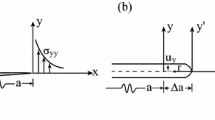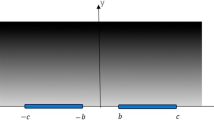Abstract
The numerical boundary integral equation (BIE) method with quadratic quarter-point crack-tip singular elements is used to analyse interface cracks between dissimilar material in axisymmetry. Such crack problems present modelling difficulties using conventional procedures for obtaining the stress intensity factors. This is because of the oscillatorily singular nature of the stresses in the vicinity of the bimaterial interface crack-tip. Analytical expressions for the direct evaluation of the fracture characterising parameters from the BIE numerical results of displacements or tractions are derived. Three different crack problems are investigated, two of which have known solutions in the literature. Excellent agreement between the BIE results and these other established solutions are obtained even with relatively coarse mesh discretisations. The present study illustrates the ease with which the BIE method may be used in the fracture analysis of both straight and curved binaterial interface cracks.
Similar content being viewed by others
References
Williams, M. L. (1959): The stresses around a fault or crack in dissimilar media. Bull. Seismological Soc. Amer. 49, 199–204
Rice, J. R.; Sih, G. C. (1965): Plane problems of cracks in dissimilar media. Trans. ASME J. Appl. Mech. 32, 418–423
England, A. H. (1965): A crack between dissimilar media. Trans. ASME J. Appl. Mech. 32, 400–402
Malyshev, B. M.; Salganik, R. L. (1965): The strength of adhesive joints using the theory of fracture. Int. J. Fracture Mech. 1, 114–128
Comninou, M. (1977): The interface crack. Trans. ASME J. Appl. Mech. 44, 631–636
Rice, J. R. (1988): Elastic fracture mechanics concepts for interfacial cracks. Trans. ASME J. Appl. Mech. 55, 98–103
Sih, G. C.; Rice, J. R. (1964): The bending of plates of dissimilar materials with cracks. Trans. ASME J. Appl. Mech. 31, 477–482
Perlman, A. B.; Sih, G. C. (1967): Elastostatic problems of curvilinear cracks in bonded dissimilar materials. Int. J. Engg. Sc. 6, 845–867
England, A. H. (1966): An are crack around a circular elastic inclusion. Trans. ASME J. Appl. Mech. 33, 637–640
Erdogan, F. (1965): Stress distribution in bonded dissimilar materials with cracks. Trans. ASME J. Appl. Mech. 32, 403–410
Toya, M. (1974): A crack along the interface of a circular inclusion embedded in an infinite solid. J. Mech. Phys. Solids 22, 325–348
Goree, J. G.; Venezia, W. A. (1977): Bonded elastic half planes with an interface crack and a perpendicular intersecting crack that extends into the adjacent material. Int. J. Engg. Sci. 15, 1–17
Viola, E.; Piva, A. (1981): Fracture behaviour by two cracks around an elliptic rigid inclusion. Engg. Fracture Mech. 15, 303–325
Hasebe, N.; Okumura, M.; Nakamura, T. (1987): Stress analysis of a debonding and a crack around a circular rigid inclusion. Int. J. Fracture 32, 169–183
Kaczynski, A.; Matysiak, S.J. (1989): A system of interface cracks in a periodically layered-elastic composite. Engg. Fracture Mech. 32, 745–756
Mossakovskii, V. I.; Rybka, M. T. (1964): Generalisation of the Griffith-Sneddon criterion for the case of a non-homogeneous body. J. Appl. Math. Mech. 28, 1061–1069
Kassir, M. K.; Bregman, A. M (1972): The stress intensity factor for a penny shaped crack between two dissimilar materials. Trans. ASME J. Appl. Mech. 36, 308–310
Lin, K. Y.; Mar, J. W. (1976): Finite element analysis of stress intensity factors for cracks at a bimaterial interface. Int. J. Fracture 12, 521–531
Smelser, R. E. (1979): Evaluation of stress intensity factors for bimaterial bodies using numerical crack flank displacement data. Int. J. Fracture. 15, 135–143
Nishioka, T.; Atluri, S. N. (1981): Analyses of cracks in adhesively bonded metallic laminates by the 3-D assumed stress hybrid FEM. In: Proc. AIAA/ASME/ASCE/AHS Structures, Structural Dynamics & Materials Conf., Atlanta, 66–70
Kuo, A. Y.; Wang, S. S. (1985): A dynamic finite element analysis of interfacial cracks in composites. ASTM STP 876, 5–34
Sun, C. T.; Jih, C. J. (1987): On strain energy release rates for interfacial cracks in bimaterial media. Engg. Fracture Mech. 28, 13–20
Sun, C. T.; Manoharan, M. G. (1989): Strain energy release rates of an interfacial crack between two orthotropic solids. J. Composite Materials 23, 460–478
Matos, P. P. L.; McMeeking, R. M.; Charalambides, P. G.; Drory, M. D. (1989): A method of calculating stress intensities in bimaterial fracture. Int. J. Fracture 40, 235–254
Yehia, N. A. B.; Shephard, M. S. (1988): Automatic crack growth tracking of bimaterial interface cracks. Int. J. Fracture. 37, 123–135
Buchholz, F. G.; Schulte-Frankenfeld, N.; Meiners, B. (1987): Fracture analysis of mixed-mode failure processes in a 3D-fibre/matrix composite cylinder. Proc. 6th Int. Conf. on Composite Materials ICCM-VI, London, England, Vol 3, 3.417–3.428
Chen, K. L.; Atluri, S. N. (1989): Comparison of different methods of evaluation of weight functions for 2D mixed-mode fracture analyses. Engg. Fracture Mech. 34, 935–956
Yuuki, R.; Cho, S. B.; Matsumoto, T.; Kisu, H. (1987): Usefulness of Hentenyi's solution for boundary element analysis of crack problems in dissimilar materials. In: Role of Fracture Mechanics in Modern Technology, G. C. Sih, H. Nisitani and T. Ishihara (eds.), Elsevier Sc. Pub., 823–834
Yuuki, R.; Cho, S. B. (1989): Efficient boundary element analysis of stress intensity factors for interface cracks in dissimilar materials. Engg. Fracture Mech. 30, 179–188
Lee, K. Y.; Choi, H. J. (1988): Boundary element analysis of stress intensity factors for bimaterial interface cracks. Engg. Fracture Mech. 29, 461–472
Tan, C. L.; Gao, Y. L. (1990): Treatment of bimaterial interface crack problems using the boundary element method. Engg. Fracture Mech. 36, 919–932
Tan, C. L.; Gao, Y. L.; Selvadurai, A. P. S. (1990): Stress intensity factors for cracks around or penetrating an elliptic inclusion using the boundary element method. Comp. Mech. Comm. (in press)
Hong, C. C.; Stern, M. (1978): The computation of stress intensity factors in dissimilar materials. J. Elasticity, 8, 21–34
Charalambides, P. G.; Lund, J.; McMeeking, R. M.; Evans, A. G. (1989): A test specimen for determining the fracture resistance of bimaterial interfaces. Trans. ASME J. Appl. Mech. 56, 77–82
Hutchinson, J. W.; Evans, A. G. (1989): On the mixed mode fracture resistance of interfaces. Acta Mettall. 37, 909–916
Kermanidis, T. (1975): A numerical solution for axially symmetrical elasticity. Int. J. Solids Struct. 11, 493–500
Lachat, J. C.; Watson, J. O. (1975): Progress in the use of boundary integral equations, illustrated by examples. Comput. Meth. Appl. Mech. Engg. 10, 273–289
Cruse, T. A.; Wilson, R. B. (1977): Boundary integral equation method for elastic fracture mechanics analysis. AFOSR-TR-78-0355 Rpt.
Blandford, G. E.; Ingraffea, A. R.; Ligget, J. A. (1981): Two dimensional stress intensity factor computations using the boundary element method. Int. J. Num. Meth. Engg. 17, 387–404
Martinez, J.; Dominguez, J. (1984): On the use of quarter-point boundary elements for stress intensity factor computations. Int. J. Num. Meth. Engg. 20, 1941–1950
Author information
Authors and Affiliations
Additional information
Communicated by S.N. Atluri, July 10, 1990
Rights and permissions
About this article
Cite this article
Tan, C.L., Gao, Y.L. Axisymmetric boundary integral equation analysis of interface cracks between dissimilar materials. Computational Mechanics 7, 381–396 (1991). https://doi.org/10.1007/BF00350167
Issue Date:
DOI: https://doi.org/10.1007/BF00350167




